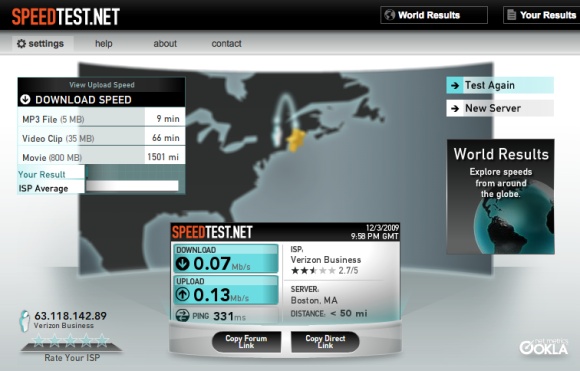
Pingdom’s management team recently visited Boston, USA, for some meetings. On their way back they had some time left over at the airport and decided to get some work done. Nicely enough, Google is currently offering everyone free Wi-Fi at a large number of US airports, including the Logan International Airport in Boston.
So, free Wi-Fi. Sounds great, right?
The problem is that the quality of the Internet connection that our colleagues got resembled something you might get in a third world country. Downloading anything but the smallest email file attachments took forever, surfing the Web was slow and unresponsive.
After swearing over the slow-as-molasses Internet connection, they decided to run an Internet speed test to see how fast the connection actually was. Here are the results:

As you can see, a download speed of 0.07 Mb/s and an upload speed of 0.12 Mb/s. Almost as bad as the old days of dial-up modems, in other words. Hardly what you’d call broadband access.
This is all pretty ironic considering Google’s focus on speed for everything Internet.
Over capacity
Google is sponsoring existing Wi-Fi hotspots on already existing infrastructure from other providers, and it’s blatantly obvious that at least the hotspot our guys were using wasn’t up to the task. It simply couldn’t handle the load. We suspect there are plenty of other travelers with similar, frustrating experiences at various airports across the US.
The funny thing here is that by making airport Wi-Fi free for everyone, and apparently not upping capacity, Google has essentially crippled access for everyone instead. No one is getting a good connection. If Google weren’t sponsoring the Wi-Fi access, fewer would be using it and performance would be better. People who are ready to pay for decent Internet access while waiting for their flight, like our colleagues, can’t.
It’s the gift that keeps on giving, at 0.07 Mb/s.
We don’t mean to be ungrateful. It’s great that Google is sponsoring Internet access for all travelers, but we suspect that in this case Google isn’t delivering the kind of quality they’d like to. The company may be less than happy with some of the Wi-Fi providers they are sponsoring.
As you know, time is money, and this time “free” cost too much.
(Of course, this was just our experience, and the situation may be much better at other places and at other times.)



























